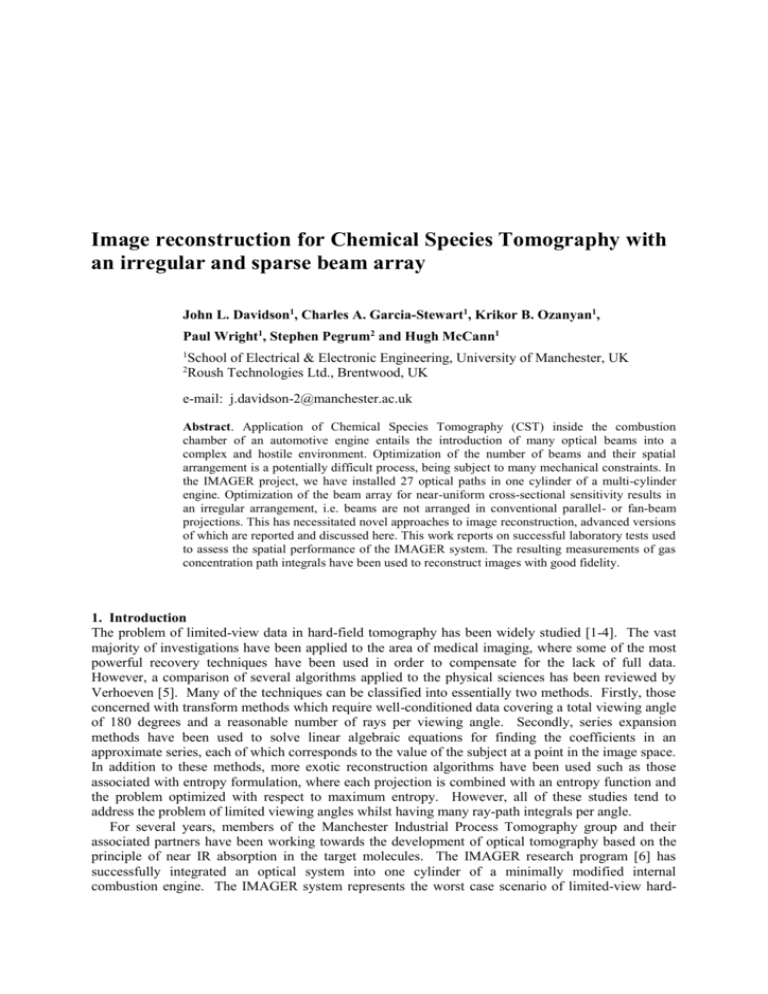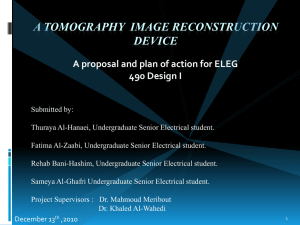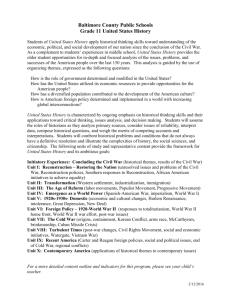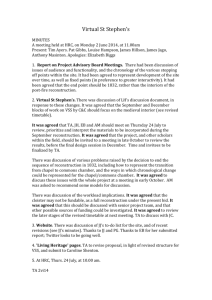Image reconstruction for Chemical Species Tomography
advertisement

Image reconstruction for Chemical Species Tomography with an irregular and sparse beam array John L. Davidson1, Charles A. Garcia-Stewart1, Krikor B. Ozanyan1, Paul Wright1, Stephen Pegrum2 and Hugh McCann1 1 School of Electrical & Electronic Engineering, University of Manchester, UK Roush Technologies Ltd., Brentwood, UK 2 e-mail: j.davidson-2@manchester.ac.uk Abstract. Application of Chemical Species Tomography (CST) inside the combustion chamber of an automotive engine entails the introduction of many optical beams into a complex and hostile environment. Optimization of the number of beams and their spatial arrangement is a potentially difficult process, being subject to many mechanical constraints. In the IMAGER project, we have installed 27 optical paths in one cylinder of a multi-cylinder engine. Optimization of the beam array for near-uniform cross-sectional sensitivity results in an irregular arrangement, i.e. beams are not arranged in conventional parallel- or fan-beam projections. This has necessitated novel approaches to image reconstruction, advanced versions of which are reported and discussed here. This work reports on successful laboratory tests used to assess the spatial performance of the IMAGER system. The resulting measurements of gas concentration path integrals have been used to reconstruct images with good fidelity. 1. Introduction The problem of limited-view data in hard-field tomography has been widely studied [1-4]. The vast majority of investigations have been applied to the area of medical imaging, where some of the most powerful recovery techniques have been used in order to compensate for the lack of full data. However, a comparison of several algorithms applied to the physical sciences has been reviewed by Verhoeven [5]. Many of the techniques can be classified into essentially two methods. Firstly, those concerned with transform methods which require well-conditioned data covering a total viewing angle of 180 degrees and a reasonable number of rays per viewing angle. Secondly, series expansion methods have been used to solve linear algebraic equations for finding the coefficients in an approximate series, each of which corresponds to the value of the subject at a point in the image space. In addition to these methods, more exotic reconstruction algorithms have been used such as those associated with entropy formulation, where each projection is combined with an entropy function and the problem optimized with respect to maximum entropy. However, all of these studies tend to address the problem of limited viewing angles whilst having many ray-path integrals per angle. For several years, members of the Manchester Industrial Process Tomography group and their associated partners have been working towards the development of optical tomography based on the principle of near IR absorption in the target molecules. The IMAGER research program [6] has successfully integrated an optical system into one cylinder of a minimally modified internal combustion engine. The IMAGER system represents the worst case scenario of limited-view hard- field tomography in terms of measurement paths. In this case, the total number of ray-sums is restricted to a maximum of only 27 beams. Previous work, from the University of Manchester has reported on the application of novel reconstruction techniques [6-7] for an earlier 32-beam regular arrangement (NIRAT) used for chemical species tomography in a laboratory based system [6,8]. This present article reports on our continued efforts to develop a new and robust reconstruction technique based on a modified Landweber iteration which has been validated with the IMAGER system using laboratory-based measurements on propane plumes. 2. Irregular and sparse beam arrays Generally, to achieve the best image reconstruction results, the measurement space should be sampled evenly in spatial and angular dimensions. However, due to mechanical constraints this is not always possible, as in the case of IMAGER. In this case, the positioning of the bulk optics is determined by physical constraints associated with the engine, leaving a small margin for designer-oriented positioning. The question then arises, given a limited set of possible sampling geometries determined by physical constraints: which of the available sampling permutations is most suited for image reconstruction? To the best of the authors’ knowledge, there is no literature available which addresses randomly sampled problems along with guidance on any associated design criteria. a) b) c) d) e) f) Figure 1 Three limited beam arrangements and the associated sinograms. Beam arrangements are for; (a) 32-beam regular geometry, (b) 32-beam irregular and un-optimized geometry and (c) reconstruction optimized irregular 27-beam geometry as used by IMAGER. The corresponding sinograms are shown in plots (d-f) respectively. One way of visualizing the quality of the irregular geometry is to look at the sensitivity coverage as reflected in the sinogram co-ordinates associated with each ray. Fig. 1 shows two limited and irregular beam arrangements and their corresponding sinograms. For comparison, a regular beam arrangement and the associated sinogram distribution or sample of the Radon transform is also shown. In medical x-ray systems the Radon space is generally well sampled both along each projection and throughout angular space, however, if a set of projection angles or ray-sums are obstructed, this appears as gaps of sensitivity in the sinogram. Consequently, the reconstructed image may contain strong artefacts. This same principle also applies to limited data problems, where leaving large gaps in the sampled sinogram reduces the overall sensitivity and introduce artefacts. Taking this into account, a critical design criterion should be to select a physically permissible permutation of measurements which gives the most uniform coverage in the sinogram. Initial attempts considered 32 beams but as can be seen in fig. 1(b and e) this yields a sinogram which is relatively poorly sampled, particularly at angles above 120° and along the extremities of each projection. Therefore, to increase the number of possible geometry permutations in the design of the IMAGER system, the mechanical design requirements were relaxed by reducing the number of beams from 32 to 27. This trade-off between number of samples and physical complexity increases the available space for placing the optical components which correspond to an increase in sensor arrangement flexibility. This flexibility means the selection of the final sampling geometry can be more influenced by imaging requirements. The resulting 27-beam sampling geometry now balances mechanical design constraints with good image reconstruction practice, and is shown in fig. 1(c). This resulting geometry offers a better distribution of angles as illustrated by the plot of the sinogram in fig. 1(f). In fact, in this case, the specific beam arrangement was determined by simulating a range of different beam arrays and selecting for optimal quality in the reconstructed image using the techniques described elsewhere [7]. 3. Image reconstruction The quality of reconstructed images from sparse data sets usually suffers from fuzziness, loss of resolution and the presence of artefacts. This is due to the highly ill-posed and undetermined nature of the problem; small changes are amplified leading to inaccurate image representation. A traditional approach to overcome limited data problems, involves the interpolation of missing projections prior to solving the inverse Radon transform. However, in the case of IMAGER, since the beam arrangement is not described by regular viewing angles each comprising of many ray-sums, using a transform technique is not viable. For this reason, we have chosen a simple technique based around an iterative Landweber method which uses median filtering within each iterative step. Essentially, the filtering process can be seen as a form of regularization, thereby attempting to reduce the inherently ill-posed nature of the problem. In addition to filtering, a further constraint of zeroing any negative solution values within each iteration was applied. This was found to improve the stability of the solution and is physically motivated i.e. a rejection of non-physical concentrations. The algorithm is shown schematically in fig. 2 and is implemented in Matlab on a standard PC. Considering a sensitivity map, S, the iterative Landweber method can be described as: Gk 1 Gk S T v SGk [1] where k is the iterative step number, G represents the solution in the image space, is the relaxation parameter and v is the measurement vector. Suitable selection of continues to be a matter of great interest in tomography research, however, an upper level can generally be described from: 0 2 ST S 1 2 [2] where the bracketed term is the reciprocal of the Euclidean matrix norm. In the case of IMAGER beam array, using a solution space based on a pixel square grid of 50 x 50, the upper limit of is relatively low and is in the order of 0.01. For this reason, initial efforts using both simulation and laboratory data have considered relaxation parameters of either 0.001 or 0.01. This was found to give consistent results and convergence to better than 1% after relatively few iterations, from 10 to 25 steps, where convergence is based on the an absolute error vector derived from the bracketed term in eq. 1. These parameters are consistent with the limited angle CT algorithms reported by Wan et al [4]. Calculate predicted measurements Compute error vector Solve using Landweber method Compute absolute error vector Set to zero any negative solution values Apply median filter ITERATE Figure 2 Schematic of the median filtered Landweber method. 4. Experimental validation The opto-electronics system developed for the IMAGER project is a system described more fully elsewhere [6]. The optical interface comprises an OPtical Access Layer (OPAL), which defines the measurement beam layout within the engine. Collimation optics within the OPAL control the launch and acceptance angles sufficiently well to allow hard-field reconstruction, even in the presence of significant scattering. A dual wavelength (1700 nm / 1651 nm) ratiometric transmission measurement is implemented on each measurement path. Although the OPAL used in this study featured 27 optical channels, only 26 were used in the work described here. The sensing field diameter, D, was 89 mm. Data were captured in 4 ms blocks at 12-bit transmission resolution during 1 s intervals, using the system’s maximum sampling rate of 100000 frames per second. The spatial resolution of the system was tested using various diameters of propane plume, either singly or in pairs. Near laminar plumes, of circular cross-section, were generated using a plenum chamber, diffuser and flow conditioning nozzle, suspended just above the OPAL as shown in fig. 3(a). Available nozzle configurations included D/3, D/4, D/5 and combinations thereof (e.g. fig. 3(b)). The OPAL itself was mounted on pillars to prevent recirculation of propane through the sensing field. The plumes could be positioned as desired using an X-Y translation stage and 45 rotational indexing. a) b) Figure 3 Arrangement for plume generation showing; (a) general view and (b) flow conditioning nozzles. 5. Results and discussion Figs. 4 and 5 show reconstructions from measurements of single plume propane data. All the reconstructions use a pixel image space based on a 50 x 50 grid but the inverse solution is only calculated in the highlighted circular region which comprises of 1844 pixels. This is a further attempt to improve the accuracy of solution by improving the conditioning of the problem. All these reconstructions use the same relaxation parameter which is set to 0.001 and 10 steps of iteration. Median filtering uses a pixel bounding box measuring 7 x 7 and is similar to an averaging filter, in that each pixel within the bounding box is set to a value determined by pixel values in the neighbourhood of the corresponding input pixel. However, unlike average filtering, the set value is the median and this reduces the sensitivity to extreme values. Consequently, median filtering is better able to remove erroneous values in the inverse solution without reducing the sharpness in the reconstruction. This can be clearly seen in the reconstructions which successfully predict both the approximate size and locality of the plumes without any significant artefacts considering the highly sparse nature of the beam array. a) b) c) d) e) f) Figure 4 Image reconstructions of a propane plume in 5 different positions and measuring approximate D/5 in relation to the sensing diameter of the OPAL. Illustration of approximate plume positions are given in (a) whilst the corresponding reconstruction are shown in (b-f). All reconstructions use the same relaxation parameter (0.001), same median filtering, 10 iterations and data from 26 beams. a) b) c) Figure 5 Image reconstructions of a D/4 propane plume in 3 different positions. In this case, the plume generator was shifted from the original position in (a) by two consecutive 10 mm increments in a vertical downward direction relative to this page. Reconstructions of these new positions are shown in (b) and (c). a) b) c) Figure 6 Image reconstruction examples of D/4 and D/3 propane plumes produced simultaneously. Approximate positions of the plumes are shown in (a) and two corresponding reconstructions using the same measurements but different algorithm inputs are shown in (b) and (c). The effect of varying reconstruction algorithm inputs is shown in fig. 6. In the case of fig. 6(b) the relaxation parameter is 0.001 and the number of iterations is 10, whist for fig. 6(c) the relaxation parameter is 0.01 and the number of iterations is 25 steps. In both cases, the median filter window remains the same at 7 x 7 pixels squared. In this case, the application of a larger relaxation parameter and more iterations suggests an improvement in the level of reconstruction accuracy. Optimization of input parameters in relation to image reconstruction quality is the subject of ongoing investigations. 6. Conclusions We have demonstrated a novel approach for systematic optimization of the measurement configuration for very sparse hard-field tomography systems. Associated image reconstruction techniques have been explored. With 26 measurement paths, reconstructed images of experimental measurements on propane plumes show a degree of spatial resolution that is highly attractive for application to incylinder diagnostics and calibration of multi-cylinder engines. References [1] Sato T, Norton S J, Linzer M, Ikeda O and Hirama M 1981 Tomographic image reconstruction from limited projections using iterative revisions in image and transform spaces Appl. Opt. 20(3) 395-399. [2] Smith R T, Zoltani C K, Klem G J and Coleman M W 1991 Reconstruction of tomographic images from sparse data sets by a new finite element maximum entropy approach Appl. Opt. 30(5) 573-582. [3] Anderson A H 1989 Algebraic reconstruction in CT from limited views IEEE Trans. Med. Imaging 8(1) 50-55. [4] Wan X, Gao Y Q, Wang Q, Le S P and Yu S L 2003 Limited-angle computed tomography algorithms Opt. Eng. 42(9) 2659-2669. [5] Verhoeven D 1993 Limited data computed tomography algorithms for physical sciences Appl. Opt. 32(20) 3736-3754. [6] Wright P, Garcia-Stewart C A, Carey S J, Hindle F P, Pegrum S H, Colbourne S M, Turner P J, Hurr W J, Litt T J, Murray S C, Crossley S D, Ozanyan K B and McCann 2005 Appl. Opt. 44(31) 6578-6592. [7] Garcia-Stewart C A, Polydorides N, Ozanyan K B and McCann H 2003 Image reconstruction algorithms for high-speed chemical species tomography 3rd World Congress on Industrial Process Tomography (Banff, Canada). [8] Hindle F P, Carey S J, Ozanyan K B, Winterbone D E, Clough E and McCann H 2001 Measurement of gaseous hydrocarbon distribution by a near infra-red absorption tomography system J. Electronic Imaging 10(3) 593-600.









